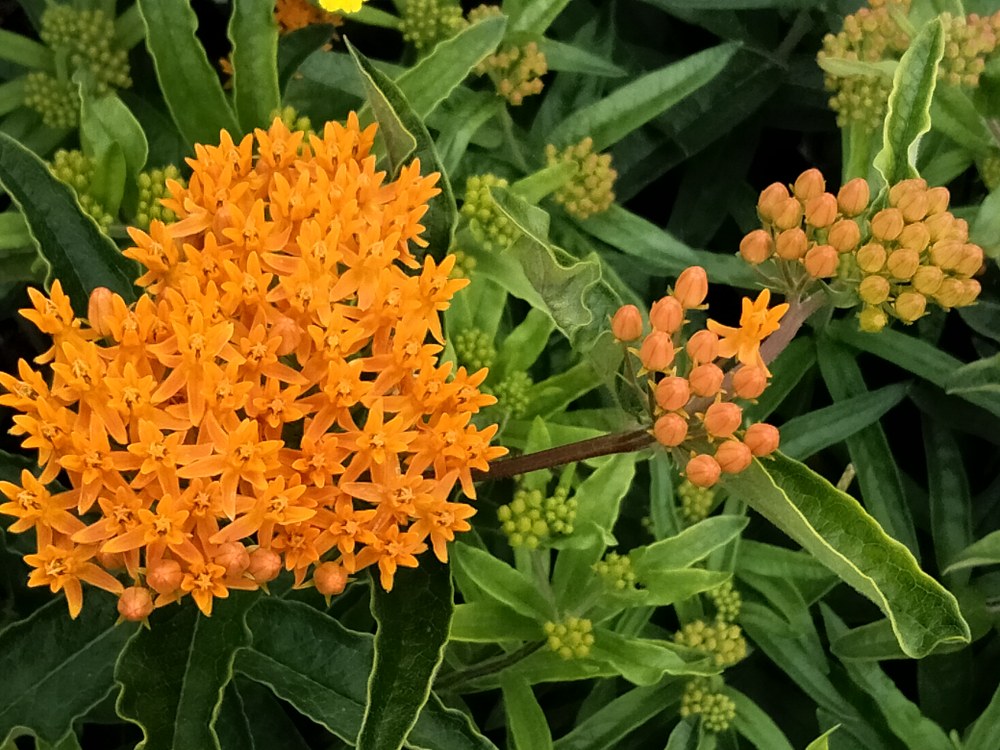The Seed Library Project contains over 15 species of native perennial flowers.

Butterfly Weed, Asclepias tuberosa. Photo credit: Melissa Wright
Many of these species require a period of cold stratification to germinate. This is an essential step for growing many native perennial flowers from seed and cannot be skipped. Without cold stratification, seeds will likely fail to germinate. For guidance on best practices for cold stratification, contact the Master Gardeners.
A sample of the native perennial flower seeds available beginning January 25, 2025:
Anise Hyssop, Agastache foeniculum:
Anise Hyssop has tall spikes with tiny lavender to dark purple flowers. The plants smell like anise or licorice, which makes this a deer-resistant plant. Pollinators love Anise Hyssop, it attracts hummingbirds, butterflies, and bees. The plant grows to three feet tall and blooms from June through September. Seeds require 30 days of cold stratification and should be surface sown in a sunny to partly sunny location that has medium moisture to dry soil.
Butterfly Weed, Asclepias tuberosa:
Butterfly Weed is a native milkweed with orange flowers that attracts birds and pollinators. It is a larval host to the monarch butterfly and is deer-resistant. Flowers bloom from June to August. Plants grow to two feet tall and prefer a sunny location. Soil should be dry and, if moist, should be well drained. Seeds require 30 days of cold stratification.
Blue Wild Indigo, Baptisia australis:
Grows four feet tall and should be planted 2-3 feet apart. Deep blue flowers grow around the stem and bloom from bottom to top, May to July. The flowers attract many pollinators. Blue Wild Indigo is deer-resistant. Seeds require 10 days of cold stratification. These seeds also require scarification (weakening of the seed coat) to germinate. Plant in full to part sun, in moist to moist-wet soil. The plant spends the first two years developing underground, and then the foliage and flowers improve each year.
Mistflower, Conoclinium coelestinum:
Mistflower can grow to two feet tall. Purplish/blue flower clusters bloom in September and October. The flowers attract late-season butterflies. Mistflower is deer-resistant and should be planted in medium wet/medium/medium dry soil and in an area that gets part sun. This plant is potentially aggressive and can take over smaller gardens. Seeds require 60 days of cold stratification. Seeds should be surface sown - no soil cover or a very light dusting of soil.
Early Sunflower, Heliopsis helianthoides:
This plant has yellow flowers that bloom from June to September. Early Sunflower is easy to grow. Soil should be medium wet/medium/medium dry. Early Sunflower can reach five feet tall and should be planted 18-36" apart. The flowers attract pollinators and birds, and Early Sunflower is deer-resistant. Seeds require 30 days of cold stratification.
Cardinal Flower, Lobelia cardinalis:
Cardinal Flower has beautiful scarlet red flowers that bloom from July through September. It is an important nectar source for hummingbirds and swallowtail butterflies and is deer-resistant. Grows to four feet tall and prefers wet to medium-wet soil. This plant is a short-lived self-seeder. Allow space for seeds to grow. Seeds require 60 days of cold stratification. Seeds should be surface sown - no soil cover or a very light dusting of soil.
Great Blue Lobelia, Lobelia siphilitica:
Great Blue Lobelia has blue-violet flowers that grow on spikes. It attracts hummingbirds, bees, and butterflies. Prefers medium to wet soils and moist areas such as ponds and creek edges. Plant in full to part sun. This short-lived perennial grows three feet tall and blooms from July through October. It is deer-resistant. Seeds require 60 days of cold stratification. Seeds should be surface sown - no soil cover or very light dusting of soil.
Wild Bergamot, Monarda fistulosa:
Seeds can be planted in spring and will germinate when planted in a warm location. Plant in full to part sun. Soil can be medium/medium-wet/medium-dry/dry. Grows to four feet tall. The purple flowers bloom from June through September. It attracts pollinators and is deer-resistant.
Mountain Mint, Pycnanthemum virginianum:
The flowers on Mountain Mint are white to light purple and can have purple spots. The leaves have a minty scent when crushed. The plant has many flowers that attract pollinators and birds. It is deer-resistant. Mountain Mint can grow three feet tall and blooms from June through September. Plant in full to part sun in soil that is wet/medium-wet/medium/medium-dry. Seeds should be surface sown - no soil cover or very light dusting of soil. Seeds will germinate when sown in a warm location.
Black-Eyed Susan, Rudbeckia hirta:
This variety of Black-Eyed Susan is a biennial that grows two feet tall. The yellow flowers with brown centers attract pollinators and birds. Plant in soil that is medium-wet/medium/medium-dry. Blooms June through September and is deer resistant. Seeds require 30 days of cold stratification.
Wild Petunia, Ruellia humilis:
Wild Petunia grows to 12” tall and has purple flowers that attract pollinators. This plant prefers full sun and medium/medium-dry/dry soil. Do not plant in shade or swampy areas. Wild Petunia can be aggressive - seeds explode, and seedlings can be found up to 10 feet away. Seeds require 60 days of cold stratification.

